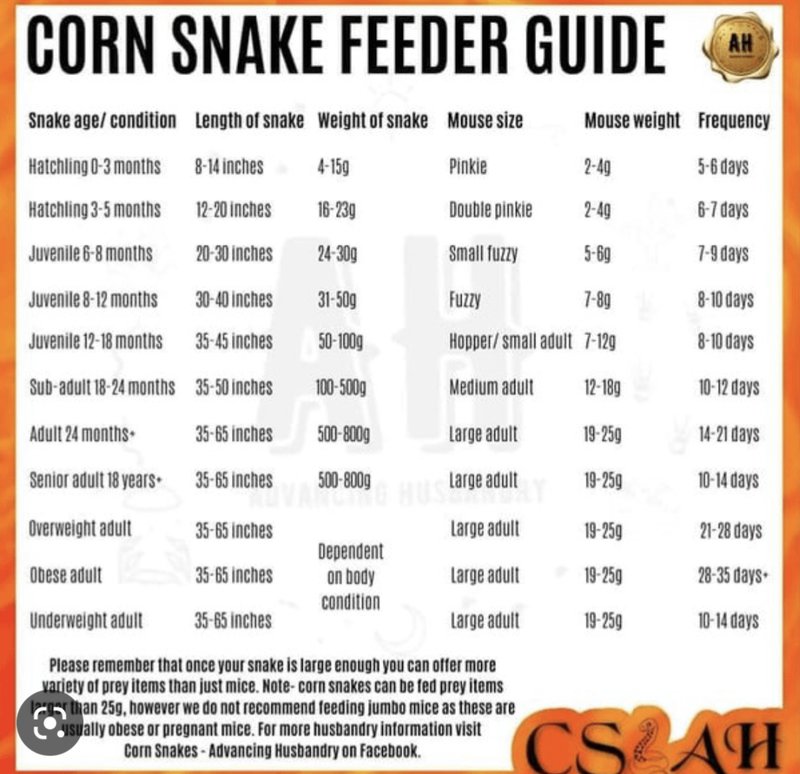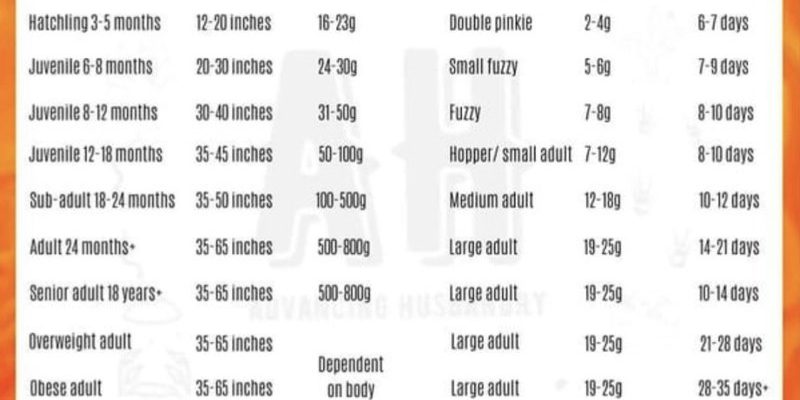
Corn snakes are fascinating creatures, known for their friendly nature and beautiful patterns. However, their feeding habits can seem a bit complicated at first glance. Don’t worry! It’s not as intimidating as it sounds. Let’s dive into what these snakes like to munch on, how often you should feed them, and even provide a handy feeding chart to make your life easier.
Understanding the Corn Snake Diet
Corn snakes are carnivores, meaning they primarily eat other animals. In the wild, their diet mainly consists of rodents, such as mice and rats. Think of them as the ultimate mousers—they help keep the rodent population in check. If you have a corn snake at home, you’ll want to replicate this diet as closely as possible.
When feeding corn snakes, it’s important to consider their age and size. Hatchlings will require smaller prey, while adults can tackle larger meals. In essence, corn snakes eat what’s available in their environment, so offering them appropriately-sized food items is key to their development and nutrition.
Let’s break down their diet even further. Corn snakes can eat a variety of prey. Here’s a quick list of common food options:
- Mice (pinkies, fuzzy, adult)
- Rats (pinky, pup, adult)
- Other small rodents
- Reptiles (occasionally, in the wild)
Understanding what they typically eat in the wild helps ensure you’re providing a balanced diet.
Feeding Frequency for Corn Snakes
You might be wondering, “How often should I feed my corn snake?” The feeding frequency depends mainly on the snake’s age. Hatchlings and juvenile snakes tend to eat more often, while adult corn snakes can go longer between meals.
Here’s a simple breakdown:
- Hatchlings (under 6 months): Feed every 5-7 days.
- Juveniles (6 months to 2 years): Feed every 7-10 days.
- Adults (2 years and older): Feed every 10-14 days.
That’s right! The younger the snake, the more frequently they need to eat to support their growth. Remember, it’s all about balance. Overfeeding can lead to health issues, while underfeeding can stunt growth.
Choosing the Right Prey Size
Let’s talk about one of the most important aspects of feeding: choosing the right size for your corn snake’s meal. Generally, the prey should be about the same width as the thickest part of your snake’s body. This ensures they can swallow it without any issues.
Feeding your snake prey that’s too large can lead to serious health problems, such as regurgitation or even injury. On the flip side, feeding them too small won’t provide the nutrition they need.
So, how do you know what size to choose? Here’s a quick guideline:
- Hatchlings: Pinky mice (the tiny, hairless ones).
- Juveniles: Fuzzy mice or smaller rats.
- Adults: Adult mice or small to medium rats.
Always keep an eye on your snake’s growth and adjust meal sizes accordingly!
Feeding Thawing vs. Live Prey
You may be curious about whether to feed your corn snake live prey or thawed frozen food. Honestly, both options have their pros and cons. Feeding live animals can be natural but poses risks to both the snake and the prey, especially if the prey is too large.
On the other hand, feeding thawed rodents eliminates these risks and is a lot safer for your snake. Plus, it’s easier on the owner since you don’t have to deal with live animals. Here’s a quick comparison:
- Live Prey: Natural hunting behavior; potential injury risk.
- Thawed Prey: Safer for both parties; less stress involved.
If you do choose thawed prey, make sure to properly defrost it—microwaving is a no-go! Instead, let it sit in the fridge overnight or warm it in warm water to prevent any drastic temperature changes that could upset your snake’s stomach.
Special Considerations for Feeding
Just like us, corn snakes can have unique preferences or health considerations when it comes to food. For example, some snakes might be picky eaters. If your corn snake refuses to eat, don’t panic! This can happen, especially during shedding or breeding seasons.
If your snake consistently turns down meals, try offering different prey types or subtly changing the feeding environment. Here are some tips to encourage eating:
- Try different prey types (like switching from mice to rats).
- Ensure a comfortable feeding area (quiet, low-stress environment).
- Adjust the time of feeding (snakes can have different active hours).
Keep in mind that suddenly changing diets or feeding schedules can upset their routine, so gradual adjustments are key.
Creating a Feeding Schedule
Now that you understand what corn snakes eat and how often to feed them, you might be thinking about creating a feeding schedule that works for you and your snake. Here’s a basic template to help you get started:
| Age | Feeding Frequency | Prey Size |
|---|---|---|
| Hatchlings | Every 5-7 days | Pinky mice |
| Juveniles | Every 7-10 days | Fuzzy mice or small rats |
| Adults | Every 10-14 days | Adult mice or small-medium rats |
Having a clear feeding schedule helps ensure you’re meeting your corn snake’s nutritional needs while also fitting seamlessly into your routine. Remember to take notes on your snake’s eating habits, as this will help you spot any changes over time.
Final Thoughts on Feeding Your Corn Snake
Feeding your corn snake is a vital part of owning this beautiful pet. By understanding what corn snakes eat, how often they need to be fed, and the importance of prey size, you’ll be well on your way to becoming a responsible and knowledgeable snake owner.
Always keep an eye on their behavior, adjust your feeding practices if needed, and remember that patience is key when it comes to feeding—whether it’s thawing food or encouraging them to eat. You’re not just feeding a pet; you’re nurturing a fascinating creature that can bring joy and intrigue into your life.
So, as you keep your corn snake well-fed, enjoy the unique bond you’re building with this amazing reptile, one meal at a time!

